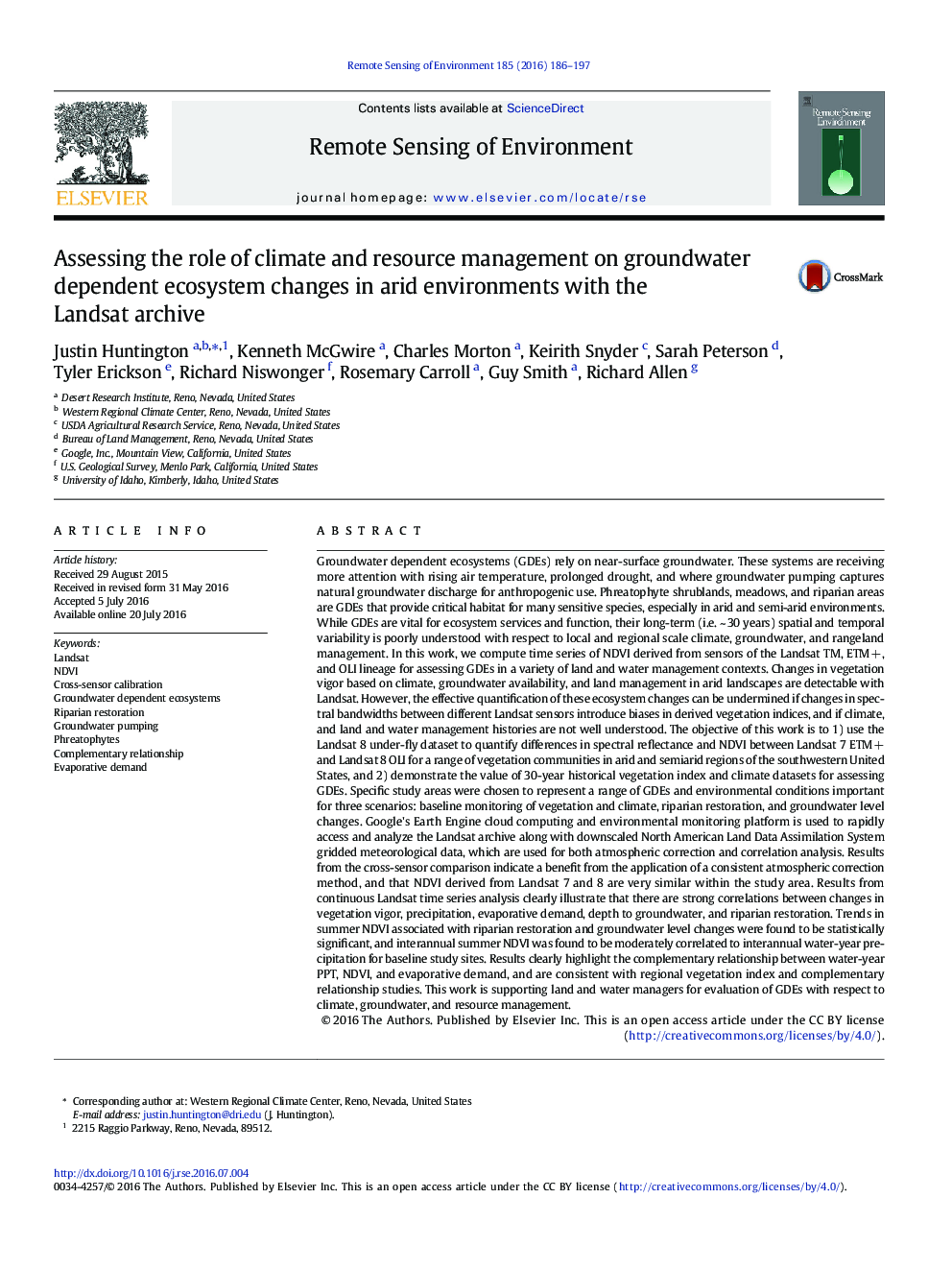| کد مقاله | کد نشریه | سال انتشار | مقاله انگلیسی | نسخه تمام متن |
|---|---|---|---|---|
| 6345006 | 1621215 | 2016 | 12 صفحه PDF | دانلود رایگان |
عنوان انگلیسی مقاله ISI
Assessing the role of climate and resource management on groundwater dependent ecosystem changes in arid environments with the Landsat archive
ترجمه فارسی عنوان
ارزیابی نقش مدیریت آب و هوا و منابع بر تغییرات اکوسیستم وابسته به زمین آب در محیط های خشک با آرشیو لندست
دانلود مقاله + سفارش ترجمه
دانلود مقاله ISI انگلیسی
رایگان برای ایرانیان
کلمات کلیدی
Groundwater dependent ecosystems - اکوسیستم های وابسته به آبهای زیرزمینیRiparian restoration - ترمیم شیرینی پزیEvaporative demand - تقاضای تبخیریComplementary relationship - رابطه تکمیلیNDVI - شاخص نرمالشده تفاوت پوشش گیاهی Phreatophytes - فراتوفیت هاLandsat - لندستGroundwater pumping - پمپاژ آب زیرزمینی
موضوعات مرتبط
مهندسی و علوم پایه
علوم زمین و سیارات
کامپیوتر در علوم زمین
چکیده انگلیسی
Groundwater dependent ecosystems (GDEs) rely on near-surface groundwater. These systems are receiving more attention with rising air temperature, prolonged drought, and where groundwater pumping captures natural groundwater discharge for anthropogenic use. Phreatophyte shrublands, meadows, and riparian areas are GDEs that provide critical habitat for many sensitive species, especially in arid and semi-arid environments. While GDEs are vital for ecosystem services and function, their long-term (i.e. ~Â 30Â years) spatial and temporal variability is poorly understood with respect to local and regional scale climate, groundwater, and rangeland management. In this work, we compute time series of NDVI derived from sensors of the Landsat TM, ETMÂ +, and OLI lineage for assessing GDEs in a variety of land and water management contexts. Changes in vegetation vigor based on climate, groundwater availability, and land management in arid landscapes are detectable with Landsat. However, the effective quantification of these ecosystem changes can be undermined if changes in spectral bandwidths between different Landsat sensors introduce biases in derived vegetation indices, and if climate, and land and water management histories are not well understood. The objective of this work is to 1) use the Landsat 8 under-fly dataset to quantify differences in spectral reflectance and NDVI between Landsat 7 ETMÂ + and Landsat 8 OLI for a range of vegetation communities in arid and semiarid regions of the southwestern United States, and 2) demonstrate the value of 30-year historical vegetation index and climate datasets for assessing GDEs. Specific study areas were chosen to represent a range of GDEs and environmental conditions important for three scenarios: baseline monitoring of vegetation and climate, riparian restoration, and groundwater level changes. Google's Earth Engine cloud computing and environmental monitoring platform is used to rapidly access and analyze the Landsat archive along with downscaled North American Land Data Assimilation System gridded meteorological data, which are used for both atmospheric correction and correlation analysis. Results from the cross-sensor comparison indicate a benefit from the application of a consistent atmospheric correction method, and that NDVI derived from Landsat 7 and 8 are very similar within the study area. Results from continuous Landsat time series analysis clearly illustrate that there are strong correlations between changes in vegetation vigor, precipitation, evaporative demand, depth to groundwater, and riparian restoration. Trends in summer NDVI associated with riparian restoration and groundwater level changes were found to be statistically significant, and interannual summer NDVI was found to be moderately correlated to interannual water-year precipitation for baseline study sites. Results clearly highlight the complementary relationship between water-year PPT, NDVI, and evaporative demand, and are consistent with regional vegetation index and complementary relationship studies. This work is supporting land and water managers for evaluation of GDEs with respect to climate, groundwater, and resource management.
ناشر
Database: Elsevier - ScienceDirect (ساینس دایرکت)
Journal: Remote Sensing of Environment - Volume 185, November 2016, Pages 186-197
Journal: Remote Sensing of Environment - Volume 185, November 2016, Pages 186-197
نویسندگان
Justin Huntington, Kenneth McGwire, Charles Morton, Keirith Snyder, Sarah Peterson, Tyler Erickson, Richard Niswonger, Rosemary Carroll, Guy Smith, Richard Allen,
